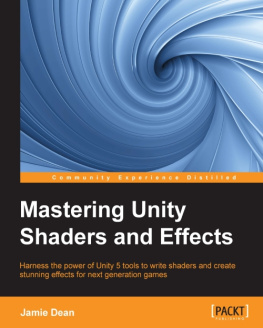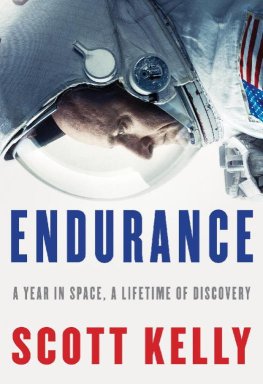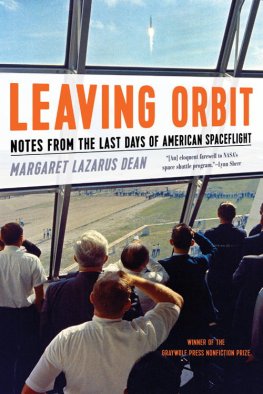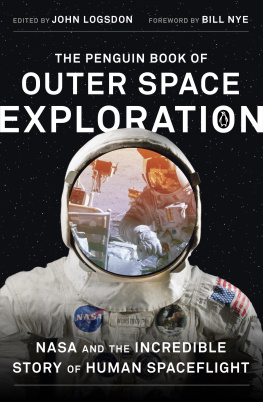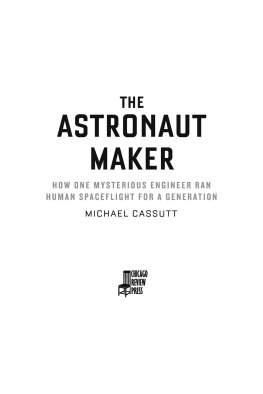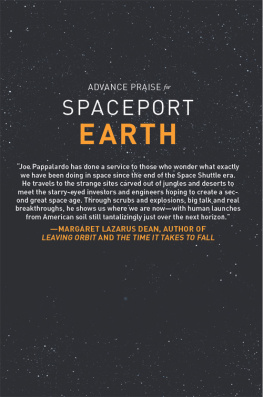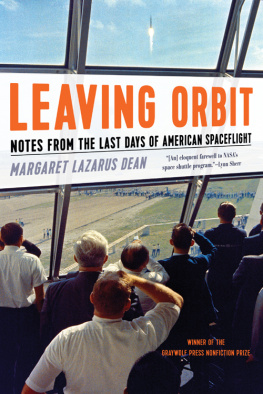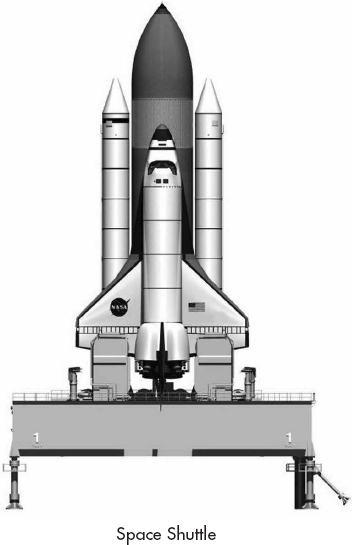LEAVING ORBIT
Notes from the Last Days of American Spaceflight
Margaret Lazarus Dean
Graywolf Press
Copyright 2015 by Margaret Lazarus Dean
This publication is made possible, in part, by the voters of Minnesota through a Minnesota State Arts Board Operating Support grant, thanks to a legislative appropriation from the arts and cultural heritage fund, and through a grant from the Wells Fargo Foundation Minnesota. Significant support has also been provided by Target, the McKnight Foundation, Amazon.com, and other generous contributions from foundations, corporations, and individuals. To these organizations and individuals we offer our heartfelt thanks.

Published by Graywolf Press
250 Third Avenue North, Suite 600
Minneapolis, Minnesota 55401
All rights reserved.
www.graywolfpress.org
Published in the United States of America
ISBN 978-1-55597-709-2
Ebook ISBN 978-1-55597-341-4
2 4 6 8 9 7 5 3 1
First Graywolf Printing, 2015
Library of Congress Control Number: 2014960047
Cover design: Kimberly Glyder Design
Cover photo: Personnel in the Launch Control Center watch the launch of Apollo 11, July 16, 1969. Kennedy Space Center Media Gallery, NASA.
To Elliot, and the future
Lovell: Well, how about lets take off our gloves and helmets, huh?
Anders: Okay.
Lovell: I mean, lets get comfortable. This is going to be a long trip.
Transcript of Apollo 8, first mission to lunar orbit, 1968
It is easy to see the beginnings of things, and harder to see the ends.
Joan Didion, Goodbye to All That, 1968
LEAVING ORBIT
PROLOGUE: Air and Space

The Smithsonian National Air and Space Museum in Washington, DC, has a grand entrance on Independence Avenue, a long row of smoked-glass doors set into an enormous white edifice. Most of the buildings nearby are marble or stone, neoclassical, meant to appear as old as the Capitol and the Washington Monument, which flank them. The Air and Space Museum, completed in 1976, is an exception: it is meant to look ultramodern, futuristic, which is to say it looks like a 1970s idea of the future.
I remember pulling open one of those doors as a child, the air-conditioning creating a suction that fought me for the doors weight. When I was seven, in 1979, I first visited the Air and Space Museum with my father and little brother, and for years of weekends after. This was what we did now that my parents had officially separated, now that our court-ordered visitation arrangements gave our weekends a sense of structure they had never had before. Divorce is supposed to be traumatic for children, and as time went on ours would become so, but not yet. For the time being, there was something festive about leaving our normal old lives and going on an outing with our father. Where we went each weekend was Air and Space.
We stepped over the threshold and into the chilled hush of the interior, one enormous room open many stories high to reveal old-timey relics of flight hanging by invisible wires from the ceiling. I knew the names of the artifacts long before I understood what they had done: The Spirit of St. Louis. The Wright Flyer. Friendship 7. As a child, I was vaguely aware that everything was out of chronological order, but I wasnt sure what the correct order was. The artifacts were simultaneously elegant and crude, all of them covered with an equalizing layer of dust. I liked to hear the sound of my fathers voice, and I liked the way he explained to me things that most adults would assume were beyond my comprehension. My father was in law school, in the midst of switching careers, but being with him at Air and Space revealed how much he missed the math and engineering he studied most of his life, all the way through a PhD from MIT. He told me about orbits, gravity, escape velocity, the Coriolis effect. I tried to understand because I wanted him to think I was smart.
I was often bored in Air and Space, but I was often bored in general: boredom was a natural state for a dreamy little kid often left, benignly, to her own devices. At home and at school I read a lot, stared out windows blankly, and took in whatever music was floating through my fuzzy consciousness: Bachs Brandenburg concertos at my fathers apartment, the Supremes and the Pointer Sisters in my mothers car, Top 40 radio at my schools extended day program where those of us with working parents went after class: Rock with You. Do That to Me One More Time. Hit Me With Your Best Shot. Another Brick in the Wall.
Even at its busiest, Air and Space was always hushed, the only sound the faraway murmurings of tourists who walked reverently past exhibits silent behind their glass. I looked at the exhibits. In the past, apparently, men ate food from toothpaste tubes while floating in space: here was one of the tubes, displayed in a case. In the past, men walked on the moon wearing space suits. Here was one of the suits, moon dust still ground into its seams. Here were the star charts the astronauts used to find their way in spacesometimes they had to do the math themselves, in pencil, and I could see their scrawled figures in the margins. Here was a moon rock, brought back to Earth in 1972, the year I was born. People lined up to touch the relic. At Air and Space, spaceflight seemed like an experience both transcendently pleasurable (the amniotic floating in zero G, the glowing blue world out the window like a jewel in its black velvet case) and also gruelingly uncomfortable (the cramped capsules and stiff space suits). No way to bathe and no privacy, the merciless nothingness just outside the spaceships hastily constructed hulls.
In the lobby was an artifact that at first looked like nothing more than a large charcoal-gray circle, thirteen feet in diameter, on a low platform in the middle of the room, encased in glass. That circle was the base of a cone-shaped object, which turned out, when you walked around it, to be the crew capsule from Apollo 11. The museums curators could have chosen to place the capsule on a pedestal, or to hang it from the ceiling, like so many of the others, but instead its position was unassuming, out on the floor where people could examine it closely. My father and brother and I did just that, and on the other side we encountered an open hatch revealing a beige interior with three beige dentist couches lying shoulder to shoulder facing a million beige switches.
My father spoke behind me. Three astronauts went to the moon in here. I noted the reverence in his voice. It took them eight days to get there and back.
Mmm, I said noncommittally. This made no sense, this claim that three full-grown men had crammed themselves into this container the size of a Volkswagen Beetles backseat, even for an hour. This story seemed like a misunderstanding best politely ignored.



